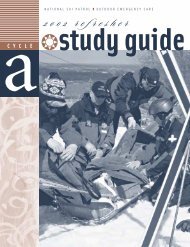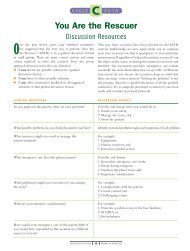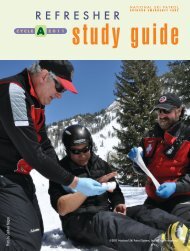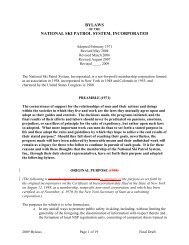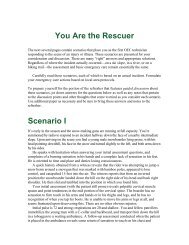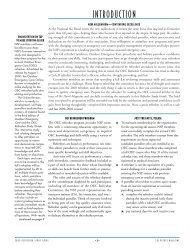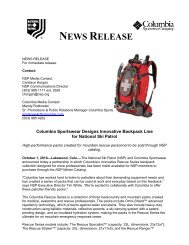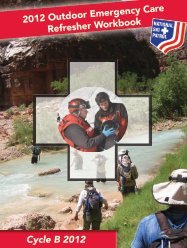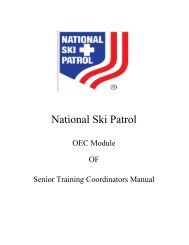Sierra Samaritans - National Ski Patrol
Sierra Samaritans - National Ski Patrol
Sierra Samaritans - National Ski Patrol
Create successful ePaper yourself
Turn your PDF publications into a flip-book with our unique Google optimized e-Paper software.
❚ CONTINUED FROM PAGE 10<br />
He also says his experience as a mountaineer assists him in<br />
his patrolling, because it provides a level of confidence in his<br />
skills and allows him to understand his limitations. “<strong>Ski</strong><br />
patrolling has also taught me how to travel safely in a winter<br />
environment and to be able to survive the coldest of nights with<br />
minimal gear,” he points out.<br />
When asked to share what inspires him about his fellow<br />
patrollers, Reneker explains that patrolling with volunteers with<br />
different backgrounds is very rewarding. “Seeing people give up<br />
their weekends to help ensure a safe and fun experience for the<br />
public has given me an appreciation for everyone in NSP,” he<br />
says. “My best friends are those I have gained in the ski patrol,<br />
and I consider them to be part of my extended family.”<br />
If there’s an unsung hero on the patrol, it is probably Lizza,<br />
who’s called patrolling a profession for more than 20 years (five<br />
at June, 15 at Mammoth, and a few years tossed in at Crystal<br />
Mountain in Washington and Las Leñas in Argentina). Diem<br />
speaks highly of him, saying Lizza has the ability to look at the<br />
big picture instead of what’s in front of him, which gives him a<br />
great eye for risk management—a key characteristic of a good<br />
patroller. Lizza grew up in the Central <strong>Sierra</strong>s and was a junior<br />
racer at Mammoth Mountain. He nonchalantly points out that<br />
he “knows June Mountain pretty well and can get anywhere<br />
pretty quick.” Translation: This guy is a great skier. But the<br />
impressive qualities don’t stop there. If you happen to have a<br />
copy of his book, The South American <strong>Ski</strong> Guide, you might<br />
know that this patroller with a penchant for ski history is also a<br />
skillful writer.<br />
Some might say that the majority of ski and snowboard<br />
patrollers are determined—after all, these people have a great<br />
deal of responsibility on the hill and in the aid room. But every<br />
so often a patroller demonstrates such “stick to it-ness” that he<br />
or she accomplishes remarkable feats in the face of insurmountable<br />
odds. Meet Patty Giebel, a 25-year patrolling veteran and<br />
prime example of a patroller who goes above and beyond the<br />
usual levels of determination.<br />
Take, for instance, the time she was attending Certified-level<br />
evaluations at Mammoth Mountain. During one of the clinics<br />
Giebel developed appendicitis and was whisked immediately<br />
down the hill to the hospital. Doctors removed her appendix that<br />
day, but instead of begging off on the clinic—as most people<br />
would do after surviving this experience—she returned to the hill<br />
the next day and passed her avalanche exam with flying colors.<br />
As if this scenario doesn’t prove the point, there are others<br />
that are perhaps even more impressive. In early 2004 Giebel was<br />
in a serious bike accident in which she sustained a broken nose<br />
and neck and stopped breathing. Fortunately her husband,<br />
Mark, happened to be with her, and was able to maintain her<br />
spinal alignment and keep her airway clear until more help could<br />
arrive. After the accident Giebel was placed in a halo to support<br />
her neck. Two weeks later, instead of calmly recuperating at<br />
home, she went to Squaw Valley, California, to attend yet another<br />
Certified clinic.<br />
One of Giebel’s passions outside of patrolling is endurance<br />
running, and nothing seems to get in the way of that rigorous<br />
pursuit. Despite her condition she decided to train for a big race<br />
from Agoura, California, to San Diego, California, a 60-mile,<br />
12-hour run. While still in her halo, Giebel worked out as she<br />
normally would—running, trail running, and doing strength<br />
training. Doctors eventually let her graduate from the halo to a<br />
hard C-collar. Two weeks later she entered the race and not only<br />
completed the run but won first place in the woman’s field and<br />
second place overall in both the mens’ and women’s divisions, a<br />
rare feat for a woman in prime condition (let alone one with a<br />
broken neck).<br />
With folks like Francisco, Diem, Reneker, Lizza, and Giebel<br />
around, it’s not difficult to imagine that new patrollers at June<br />
Mountain have good mentors. Then again, some just take to<br />
patrolling naturally. One such newbie is Tony Golden. The<br />
2003–04 season was his first as a patroller, but you wouldn’t<br />
guess it from accolades he receives from Francisco: “Tony is a<br />
self-starter who tackles projects with enthusiasm and completes<br />
them competently, requiring little or no direction.” Golden<br />
shrugs off his hard work, saying “I’m just into it.”<br />
That much is clear. Golden completed his candidate training<br />
within his first month of patrolling at June, spending 12 days on<br />
the mountain in the first 20 days the area was open. Overall, during<br />
the 2003–04 season, he devoted more than 400 hours to the<br />
June Mountain <strong>Patrol</strong> in on-hill and off-hill duty time.<br />
Golden asserts that his experience at June Mountain has<br />
taught him a lot in just a short time.“From the beginning I’ve been<br />
placed in the ‘deep end,’ working scenes right from the get-go.”<br />
Originally from the East Coast, where he grew up skiing in<br />
the ’60s at a small resort with a strong family atmosphere,<br />
Golden says he is looking to recreate this feeling with his family,<br />
and June Mountain is just the place to do it. Hence, he had a<br />
hand in recruiting his wife, Lynn, to also help out at the area. Full<br />
of positive energy and a real go-getter in her own right, Lynn<br />
helped initiate June’s mountain host program and served as one<br />
of the area’s four original mountain hosts during the 2003–04<br />
season.“June is special because they care about every person who<br />
comes to the mountain,” she says.<br />
Clearly, they’re doing something right at June Mountain.<br />
Between the camaraderie, training, and downright dedication to<br />
making a safer go of the slopes they love, area management and<br />
this small group of patrollers work magic in the shadows of<br />
Mammoth. And while big sister might be more well-known,<br />
little sister June is no wallflower. ✚<br />
Ingrid Tistaert, former assistant editor for <strong>Ski</strong> <strong>Patrol</strong> Magazine, now works as a<br />
freelance writer and editor. She lives in Tahoe City, California.<br />
14 <strong>Ski</strong> <strong>Patrol</strong> Magazine | Winter 2005




